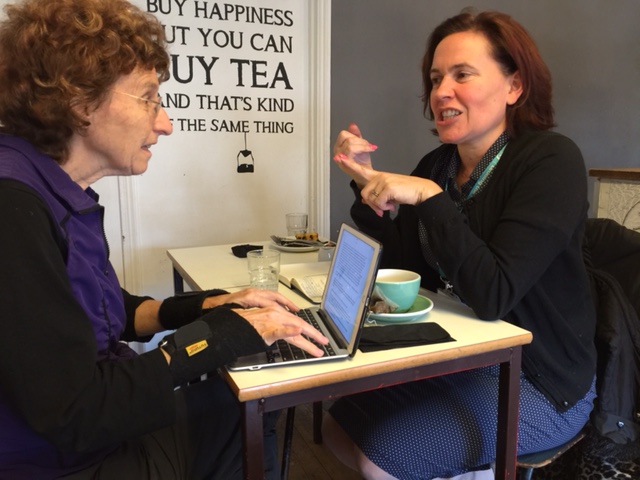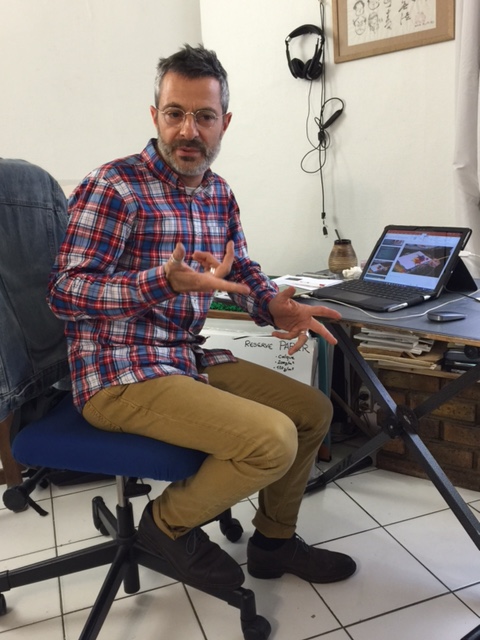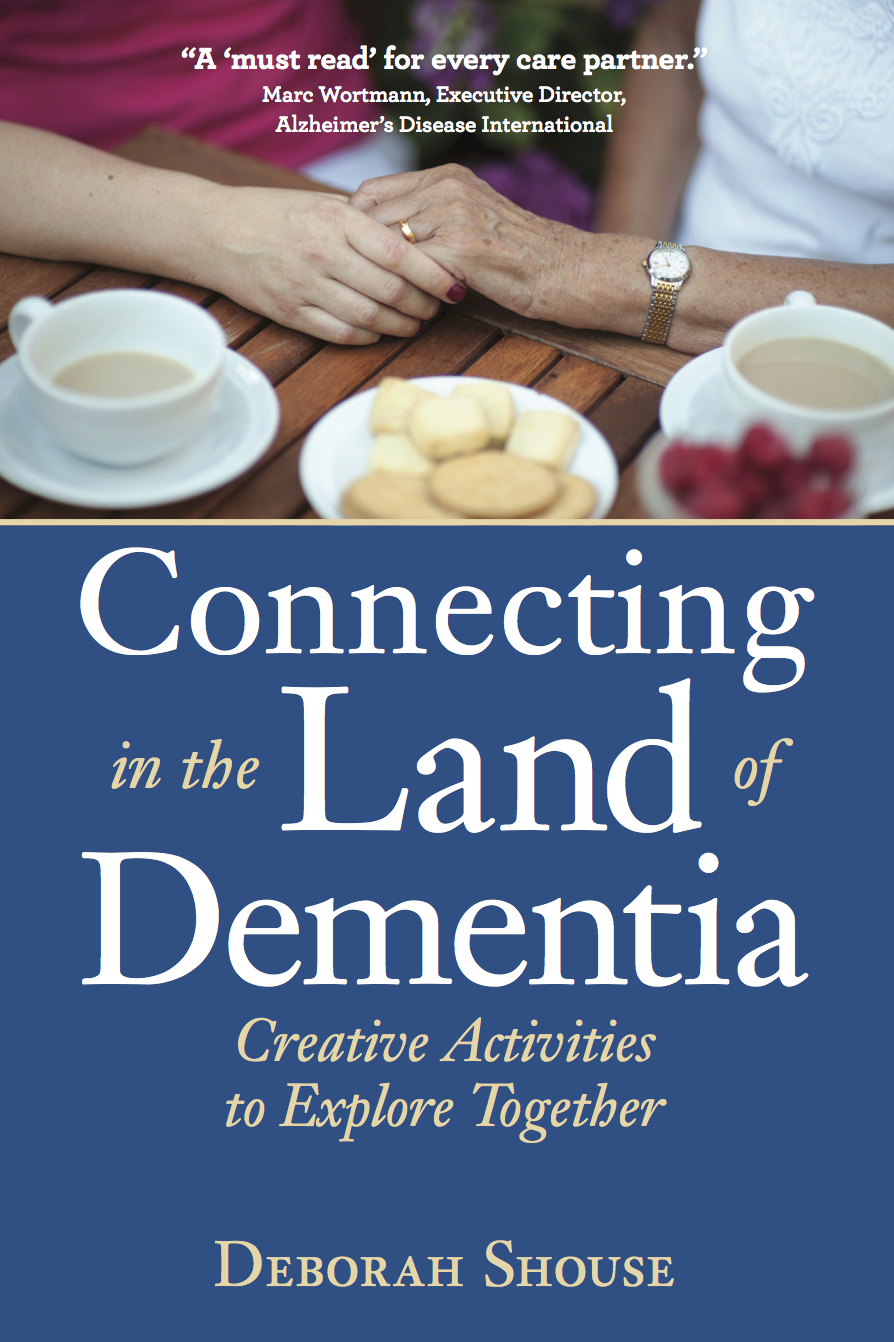Archive for August 2016
An Art Lesson in Paris
An integral part of experiencing Paris is looking at art. Chantal Debreu, a psychotherapist, serves as a volunteer and board member of the city’s Action Culturelle Alzheimer. To properly discuss the fascinating programs Chantal and her colleagues designed in collaboration with Musée d’Orsay, Musée de Cluny, and the Château de Versailles, we met at a sidewalk café over croissants and coffee.
(Note to fellow writers: It is extremely difficult to enjoy a croissant while typing on an iPad. The flakes flutter festively about the keyboard.)
Art Speaks a Universal Language
“Art is a universal language and looking at art is a wonderful way to access the creative capacities of people living with dementia,” Chantal says. “Looking at and discussing art can also at least temporarily reduce issues such as agitation, depression, apathy, and aggression.”
To facilitate such cultural connections, Chantal and Cindy Barotte, founder of Action Culturelle Alzheimer, created a three-day training program for volunteers, complete with information about dementia, case studies, and role play. Cindy developed a structure for finding meaning in works of art for volunteers and museum educators. The program connects each beneficiary with a trained volunteer who is there for five gallery visits. During the art experience, the caregiver has much-needed respite time.
“The volunteer helps people living with dementia explore their own capacities by supporting them,” Chantal says.
 The structure encourages engagement and creative expression. To view the work of art, participants sit in a semi-circle, so they can see and hear each other. The semi-circle creates a sense of group belonging and also blocks out the public. The volunteers sit in back of their person. If the person with dementia feels shy about speaking out, they may turn and share with their volunteer. The volunteer reports the insight to the educator, who shares it with the group.
The structure encourages engagement and creative expression. To view the work of art, participants sit in a semi-circle, so they can see and hear each other. The semi-circle creates a sense of group belonging and also blocks out the public. The volunteers sit in back of their person. If the person with dementia feels shy about speaking out, they may turn and share with their volunteer. The volunteer reports the insight to the educator, who shares it with the group.
Art Breaks Ice and Inspires Ideas
The program inspires conversation and ideas. People living with dementia tend to notice the details, but they may not attach a meaning to them. Little by little, the facilitators talk through the elements of the painting, helping them associate and build meaning, so they understand the story of the painting. When they start to make associations, they talk about their experiences. They come away feeling like they are someone; they have ideas and memories to share.
“At the Centre Pompidou, we discussed Bleu, a giant Miro canvas,” says Chantal. “We talked about it for 15 minutes. Everyone was involved and actively engaged in investigating, wondering, and sharing.”
Art Travels with You
Want to bring the Paris art experience home? Here are some tips:
- Select a work of art to comfortably view together, either on-line, from a book, or at a local gallery.
- As you look, ask open-ended questions, such as, “Why is that woman staring?”
- Encourage conversation by continuing to ask engaging questions. If someone notices a bicycle, make an affirming comment about the bicycle and ask “What else do you see?”
“It’s not about telling,” Chantal says. “It’s about asking.”
For more on the international scene, dive into my book, Connecting in the Land of Dementia: Creative Activities to Explore Together. Pre-order your signed copy.
Building London’s Bridge between Dementia and the Community
Imagine a global community of people diligently working to make the world a better place for people who are living with dementia. We met a few of the esteemed people who are making a difference on a recent trip to the United Kingdom and to France. Esther Watts has a passion for creating dementia friendly communities that is contagious. Talking to her gave us a lot of ideas and spurred us onward to collaborate on a dementia-friendly movie event in Kansas City. Plus, her workplace is located near the Thames and after our meeting, she took us to see the Queen’s Golden Barge, which was quietly waiting for its next chance to carry Her Majesty.
London is already one of the world’s great cities and Esther Watts is helping to make it, and other cities throughout England, even better. As coordinator of the Alzheimer’s Society’s Dementia Action Alliance (DAA), she orchestrates policies, events, and activities tailored to people living with dementia.
Esther and a team of Dementia Action friends have contacted bus companies, arts organizations, retailers, sports authorities,and hospitals in behalf of those living with dementia.
“Our goal is to keep people going out in their communities, enjoying new experiences and meeting new people,” Esther says. “We want people to feel comfortable and welcomed.”
 Royal Ways to Create Community Experiences
Royal Ways to Create Community Experiences
She and her team collaborate with some distinguished clients, including the Victoria and Albert Museum, Kew Gardens, the Royal Academy of Arts, historic Royal palaces, such as Hampton Court, and various sports organizations.
One of her projects was a dementia-friendly cricket match. Esther and her team scored free tickets for fans that are living with dementia and their families. They had plenty of trained Dementia Friends on-hand to welcome these fans and escort them into the stadium. There they showed a special short film on the history of cricket and shared items from the cricket museum. For those who needed respite from the excitement of the match, the stadium offered a designated “Quiet Room.” When London celebrated Dementia Awareness Week, DAA wrote the Society of London theaters, asking for dementia-friendly playgoing experiences.
 Advocates pledge to take three action-steps, which can be as simple as visiting a friend who is living with dementia or as complex as creating a self-guided museum tour for people living with dementia.
Advocates pledge to take three action-steps, which can be as simple as visiting a friend who is living with dementia or as complex as creating a self-guided museum tour for people living with dementia.
“Dementia Awareness Week gives a community a focus,” Esther says. “DAA is about what we can do together.”
##
Please share your ideas for action-steps. One of mine is to try to stay in regular touch with friends who are living with dementia.
For more on the international scene, dive into my book, Connecting in the Land of Dementia: Creative Activities to Explore Together. Pre-order your signed copy.

Three Benefits of Artistic Alchemy
Last week, I wrote about Julian West and his work with music and dementia. Hannah Zeilig, PhD, is an expert in culture, language, and dementia, who participated in and documented Julian’s program. When I interviewed Hannah, I was inspired by her perspective on arts and communications and wanted to share a few of her key ideas.
“The project showed us that you can converse in so many ways,” says Hannah. “The musicians and the dancer reminded us that we all can communicate without language.”
“One of the questions we’re asking in the UK is ‘How can the arts help with dementia? What can arts do that a game of dominoes cannot?’ ” Hannah says. “The arts help people become brave in how they connect with each other.”
The arts also transcend our dependence on achievement, identity, and memory.
“Being scared of dementia is the biggest barrier,” Hannah says. “In our language and our media, dementia is stigmatized and portrayed as catastrophic. One of the natural and common fears is summarized by this: ‘If I can’t remember where I live and my achievements, how do I know who I am?’
Julian’s work reminds us that we are all creative.
“People with dementia can be brimming with creativity and humor and able to make connections with each other,” Hannah says.
During one of Julian’s sessions, the musicians were playing and the dancer was cavorting around the circle. One resident, Alicia, walked right up, took the dancer’s hands and lead her in a waltz.
At the end of the dance, Alicia was glowing. She smiled and said, “We really just did something.”
And she was right.
….
Other gifts from this work in the arts:
- The residents communicated with more sounds and gestures.
- The staff saw the creative side of the residents.
- The creative atmosphere opened everyone up to alternate ways to connecting.
For more about Hannah and her work, visit:
Orchestrating a Musical Conversation
When Ron’s dad was living in a memory care unit, Ron and I talked with the residents and their families, learning about their favorite songs. We orchestrated a sing-along and had fun working with everyone and putting together a scrapbook of each resident’s special tunes. The combination of music and conversation created a sense of community for us all. Julian West, who we met on a recent trip to London, is creating community through engaging people in music and dance. We really love the way he weaves the two art forms together and wanted to share his easy and adaptable ideas with you.
Julian West had no idea what would happen at the care facility, but he trusted it would be something wonderful. An accomplished oboist and a teacher at the Royal Academy of Music, Julian assembled a violist, a composer, a dancer, and an artist to share energy and their art with people who are living with dementia.
“This was an experiment to see what could happen,” Julian says. “We worked completely improvisationally.”
Once a week, for eight weeks, the troupe came to the residential care home and created a living arts experience with residents and staff. They began by inviting everyone to choose a percussion instrument, such as rain sticks, bells, shakers, tambourine, etc.
“We had a musical conversation,” Julian says. “One person made a sound and another answered. We also chatted a lot. People commented on the music or expressed an emotion or impression.”
The musicians added their instruments and the staff and residents joined in, through percussion and voice. They made fascinating sounds, like an improv jazz singer might do. The dancer twirled around in the center of their circle. Her free movements gave the group a focal point and inspired others to explore various movements.
“I let go of preconceptions and tried to create an open atmosphere,” Julian says.
The artists’ openness helped the “conversation” grow and blossom.
One woman who was living with dementia held up a tambourine, keeping it still and gazing at it as though it were a beautiful and revered object.
Julian’s first thought was, “She doesn’t know it’s a musical instrument”.
“I let that thought go,” he says. “I saw how expressive she was. Her interaction with the tambourine was beautiful and profound and she allowed us all to see the instrument differently.”
Even if you don’t have your own musicians and dancers at home, you can still create this supportive and creative atmosphere.
- Share a few percussion instruments, put on some music you both like, and make some joyful noises. Experiment with bee-bop syllables to add a sense of freedom.
- After the song, talk about the experience, what you liked, what you felt, and any other impressions that came up.
- Consider inviting a “guest dancer,” someone who likes to move to music, or a child of a friend who’s taking dancing lessons. Go ahead and add your own moves.
- Invite friends and family to join you. You’ll have something to laugh, and sing, and talk about.
For more information about Julian’s work, visit: www.julianwest.co.uk
Tips from a Parisian Artist
 There’s something magical about visiting an artist in his studio. Especially if that studio is in Paris. We were honored to meet Patrick Laurin, artist and art therapist, on a recent trip to France.
There’s something magical about visiting an artist in his studio. Especially if that studio is in Paris. We were honored to meet Patrick Laurin, artist and art therapist, on a recent trip to France.
In the beginning, Patrick Laurin’s work with people who were living with dementia went slowly. When he first visited the care home and invited people to join him for painting, he heard various reasons the idea wouldn’t work. “I can’t hear you.” “I can’t see you.” “I can’t move my arm.”
 Patrick, who had quit working as researcher in the pharmaceutical industry so he could create deeper connections with clients, understood the importance of building relationships. Gradually, he got to know the people who lived in the community. He wanted to tailor an artistic experience specific to each person’s abilities and needs.
Patrick, who had quit working as researcher in the pharmaceutical industry so he could create deeper connections with clients, understood the importance of building relationships. Gradually, he got to know the people who lived in the community. He wanted to tailor an artistic experience specific to each person’s abilities and needs.
Over time, the people who couldn’t see, hear, or move were all happily involved in painting.
One woman seemed to blossom when holding the brush and stroking on the paint. Even though she couldn’t later remember to say, “I’ve been painting,” she enjoyed the experience.
One day, Patrick was on another floor in the care community when he encountered this woman and her daughter.
Her daughter said to Patrick,” You are the painter.”
Patrick was thrilled her mother had been able to mention the art therapy sessions. But before he could respond, the mother said, “No, the painter is me.”
“Inside, she was seeing herself as an artist,” Patrick says. “The painting strengthened her identity.”
 Patrick has learned to approach each person with flexibility. Sometimes Patrick jump starts his artists with a squiggle of color on the page. Then he steps back to let them respond with their own squiggle. If they’re stymied, he offers a choice of two colors.
Patrick has learned to approach each person with flexibility. Sometimes Patrick jump starts his artists with a squiggle of color on the page. Then he steps back to let them respond with their own squiggle. If they’re stymied, he offers a choice of two colors.
He also uses collage techniques to inspire his artists. He selects three separate pictures, each with one recognizable thing, such as a house, tree, or dog. He shows the photos to the artist, and asks, “Which one of these attracts you?” When the artist chooses a photo, Patrick then asks, “Where would you like to put this on the paper?” He and the artist apply paste to the paper.
“We don’t turn over the picture and apply paste, because the image then disappears and that can be confusing,” he says.
When the picture is glued to the paper, Patrick discusses a color that’s already in the picture.
“You could take the blue in the sky and extend it,” he might suggest. This suggestion often inspires the artists to start painting. If they get stuck, Patrick says, “What might look good near the house?” In this way, the painting expands.
For one woman, painting began as a series of colors and grew into a personal story.
She pasted a house and began expanding the lawn. Then she drew a bridge and weeks later, she added in a dog. At first, she was painting “a house, a bridge and a dog.” As the picture took shape, she said, “This is my house and my dog and this is the bridge we had to cross to get to the house.” The process of painting had loosened memories of her childhood home.
 “When I share a piece of art by one of my students, I also share the story behind it,” Patrick says. “The act of creation is more important than the results.”
“When I share a piece of art by one of my students, I also share the story behind it,” Patrick says. “The act of creation is more important than the results.”
Tips:
Pick something that is easy for you, the care partner.
Put a point of color on the pages, then stand back. Offer support but don’t paint.
Enjoy the process and don’t get stuck on the results.
Thanks to Berna Huebner, founder of the Hilgos Foundation and co-producer of the documentary, “I Remember Better When I Paint,” for suggesting we meet with Patrick.

